by Todd Rutherford
You may have heard recent dire reports about the health of bees and butterflies. Whether it’s the declining number of the amazing Monarch Butterfly or the constant reports of “colony collapse disorder” in beehives, these reports are alarming. One of the best and easiest things you can do to help these crucial creatures survive and thrive is to plant the perennials, shrubs and trees in your landscape that will give bees and butterflies the food they depend on. Help these pollinators while creating an inviting outdoor space for yourself. Or, if you are pondering the possibility of updating your landscaping in the near future, let Outdoor Design Group design a bee and butterfly friendly garden for you.
Below are listed several different perennials, shrubs and trees that provide food for bees, butterflies and other pollinators. While I’ve listed several pollinator friendly plants here, there are still many more to choose from. Consult the Xerces Society, a nonprofit organization that protects wildlife through the conservation of invertebrates and their habitat, or your local university extension agent for more suggestions of pollinator friendly plants that will grow well in your area.
Perennials for Butterflies and Bees
Asclepias species. Commonly referred to as the Milkweeds due to their milky sap, there are many species in the Asclepias genus that are utilized by butterflies and bees. Many biologists believe that the decline in the Monarch butterfly population is directly correlated to the increasing use of herbicides used to kill Milkweeds in North America, because Monarch butterflies depend on Milkweeds as food for their larvae. There are many Asclepias species that grow in North America, but two that do well in Colorado are Asclepias tuberosa (showy milkweed) and Asclepias speciosa (butterfly weed). Ht. and Wd. varies depending on species and cultivar, generally 15-60” Ht. x 12-18” Wd.
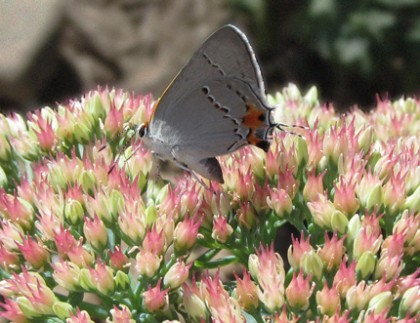
The Mint Family (Lamiaceae). Many familiar and popular garden plants from the so-called Mint Family are favored by bees. Some of these are culinary sage, Russian sage, mint, basil, rosemary, oregano, thyme, lavender, lamb’s ear, hyssop, lemon balm, and bee balm. Ht. and Wd. varies depending on species and cultivar.
Sedum ‘Autumn Joy’. This tall stone crop flowers in mid to late summer (see photo above), making it a good late-season nectar source for pollinators when many other plants have stopped flowering. 18-24” Ht. x 12-18” Wd.
Datura wrightii Although Sacred Datura may not always be a perennial in all parts of Colorado, depending on the severity of the winter, bees love it’s flowers which emit an amazing scent, so even if it is frost tender and may need to be regrown from seed in colder areas, it is worth it. The bees will thank you. 18-24” Ht. x 6-8’ Wd.
Shrubs for Butterflies and Bees
Buddleia alternifolia ‘Argentea’, Silver Fountain Butterfly Bush. This butterfly bush blooms earlier than the other species and cultivars of Buddleia. This large shrub does well in most soils and sites but doesn’t like its roots to stay wet. 12-15’ Ht. x 10-12’ Wd.
Caryopteris x clandonensis ‘Blue Mist’. Blue Mist Spirea is also in the Mint Family, and is not a true spirea, but has flowers that resemble those of the spirea. It is a hybrid of C. incana x C. mongolica that was created in the 1930’s in England by Arthur Simmonds. There are several cultivars of Caryopteris x clandonensis that are good choices for Colorado and which bees and butterflies (see photo below) love. 3-4’ Ht. x 2-3’ Wd.
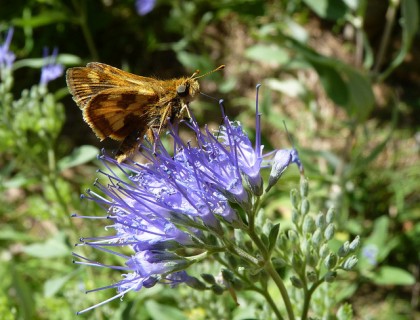
Mahonia. This genus has several members whose flowers will delight your winged friends. Mahonia aquifolium is a familiar shrub known as Oregon Grape Holly. It is evergreen, easy to grow and produces edible (but not tasty) berries from the yellow flowers that bees appreciate. 4-6’ Ht. x 4-6’ Wd.
Prunus bessyi, Sand Cherry 4-6’ Ht. x 4-6’ Wd.
Philadelphus lewisii, Cheyenne Mock Orange 5-7’ Ht. x 4-6’ Wd.
Rhus aromatica ssp. Trilobata, Three leaf sumac 3-6’ Ht. x 3-6’ Wd.
Rosa woodsii, Wood’s Rose 3-6’ Ht. x 3-6’ Wd.
Trees for Butterflies and Bees
Tilia cordata, Little Leaf Linden. Linden trees perfume the air in springtime and offer up small yellow flowers (see photo below) for pollinators. I’ve heard that in Eastern Europe, a type of beer is flavored with the linden flowers. 30-50’ Ht. x 25-35’ Wd. (depends on cultivar).
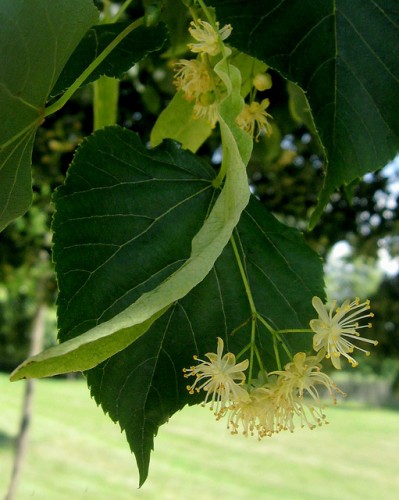
Apple / Crabapples. The Malus genus offers many species and cultivars that are attractive to bees. In fact, if there were no bees, you probably would not get any fruit from your apple trees. Ht. and Wd. varies depending on cultivar.
Prunus armeniaca ‘Moongold’, Moongold Apricot. 15-25’ Ht. x 15-25’ Wd.
Prunus nigra ‘Princess Kay’, Princess Kay Plum 15-20’ Ht. x 10-15’ Wd.
Catalpa speciosa, Western Catalpa 40-60’ Ht. x 30-50’ Wd.
Cercis Canadensis, Eastern Redbud 20-30’ Ht. x 20-30’ Wd.
Crataegus ambigua, Russian Hawthorne 15-25’ Ht. x 20’ Wd.
This is the official blog of Outdoor Design Group, Colorado Landscape Architects. For more information about our business and our services, click here.
Related Posts:
by Todd Rutherford
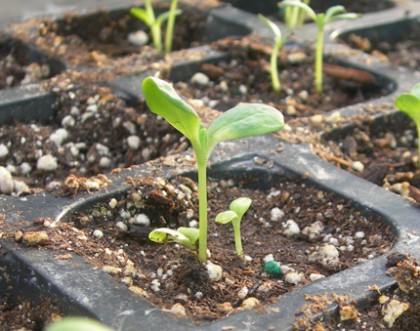 If you are a “plant person” you’re probably aware of the option of growing your own plants from seed indoors. If you’ve never tried it before, it is definitely worth the experience. Not only is it a great way to save money over buying your plants at a nursery, it is also fascinating to watch the plants sprout and mature under your care. As an added bonus if you’re interested in uncommon plant varieties, this is a way to get your hands on those hard-to-find plants from native flowers to heirloom crop plants.
If you are a “plant person” you’re probably aware of the option of growing your own plants from seed indoors. If you’ve never tried it before, it is definitely worth the experience. Not only is it a great way to save money over buying your plants at a nursery, it is also fascinating to watch the plants sprout and mature under your care. As an added bonus if you’re interested in uncommon plant varieties, this is a way to get your hands on those hard-to-find plants from native flowers to heirloom crop plants.
TIMING
When you start your seeds indoors is dependent on when you want to plant your seedlings outdoors. And that is obviously dependent on what plant hardiness zone you live in, and the hardiness of the seeds you will start. Here in the urban Front Range of Colorado, some gardeners refer to the middle of March as a good average time to start many vegetable seeds indoors. Our last day of frost is usually in the first week of May. That roughly translates to about 6-8 weeks of indoor growth for your seeds before you can safely plant them outside. Search the internet to determine your local plant hardiness zone, and read the seed packet to determine how long germination takes for your seeds. Plant species vary in the time needed before they can be transplanted outside.
TOOLS
Like many DIY projects, you can invest as much time and money or as little as you’d like on starting seeds indoors. Some people utilize complicated equipment, such as special shelves and lights, and miniature green houses to start seeds. Others keep it simple and start their seeds in soil filled Dixie cups on the windowsill.
I believe one essential ingredient for seed starting success is a sterile seed-starting mix. This is a “soil-less potting soil” mix that offers a texture that is just right for seeds to germinate. Using any other type of soil for indoor seed germination may lead to the seedlings succumbing to a fungal rot. You can buy pre-made mixes or make your own.
Many people use seed starting trays which are readily available at garden centers and home improvement stores. These come with many options like a wicking mat to keep the seed mix properly moist, or a heating pad to maintain ideal temperature. I’ve gone the less expensive route and used left-over food containers with clear lids (like salad mix boxes). Inside these boxes I place small store-bought peat pots filled with seed start mix. If you reuse a food container or seeding tray, wash it with soap and hot water, and rinse in a dilute chlorine/water solution to sterilize them.
TECHNIQUE
Fill your trays or pots about ¾ full with lightly moistened seed mix medium. Place the seeds on the medium and then cover with more seed mix medium to a depth of roughly three times the thickness of the seed (Or the recommended depth as stated on the seed packets). Some seeds require sunlight to germinate, and so should not be covered at all. Also included on the seed packets is information about when to best sow the seed.
Whether you use a seed tray or a leftover food box, it’s important to utilize a clear lid or plastic wrap to cover the seeds before they germinate. This provides a moist environment which promotes germination, yet allows light to reach the soil surface. However once the seedlings reach 2 inches tall, you’ll want to uncover the seedlings so they are not too wet and so more light can reach the seedlings. If it is too wet, the seedlings may rot.
Ideal temperature for the germination of most seeds is 72 during the day, and 65 at night. Protect the germinating seeds from cold drafts. But seedlings don’t need to be kept as warm as germinating seeds. Move them off any heating mats, and away from any heat sources.
To avoid the seedlings getting too leggy and elongated, it is recommended that you place them in a sunny spot and/or suspend fluorescent lights 3 inches above the tray. Raise the light as the seedlings grow. If no supplemental natural light is available, adding an incandescent light bulb can help produce better growth in the seedlings.
Once seedlings have developed four “true” leaves (and not just the cotyledons or embryonic “first leaves”) you can fertilize with ¼ strength water-soluble fertilizer. If they are in small pots or the “cells” typical of the seed starting trays, you can transplant them to their own larger pots to give them more room to grow before they are planted outside. Be aware that some vegetable and annual seedlings don’t transplant well and should go directly from the original seed-start containers into the garden.
If you planted too many seeds per individual pot or tray cell, your seedlings may be crowded and you should consider thinning out excess seedlings to avoid competition for soil nutrients and water. Do this by carefully snipping unwanted and week seedlings with scissors. It is best to prune out the extra seedlings before they reach 2 inches tall.
If your seedlings are looking spindly or elongated, petting them gently with your hand once or twice daily will help to stimulate more stocky growth. This artificially simulates the wind the seedlings would encounter if they were growing outdoors. You can also set up a small gentle fan to continuously blow on the seedlings. This is done in many commercial greenhouses. If you utilize a fan, be sure to not allow the soil surrounding the seedlings to dry out too much.
Around two weeks before planting your new plants in the garden, harden them off by moving them outdoors on warm days to a shaded porch, and then back inside during the evening.
One thing to keep in mind is that some types of plants are inherently easier to start from seed. You will notice this as you look at the seed types available for sale in garden centers. However, don’t be limited by this selection. Consider collecting, saving and swapping seeds with friends and neighbors. And don’t forget to keep track of which seeds did well, and which ones produced desired results so you can repeat your success next year.
This is the official blog of Outdoor Design Group, Colorado Landscape Architects. For more information about our business and our services, click here.
Related Posts:
by Todd Rutherford
As you are all probably aware, we live in a semi-arid climate in Colorado. Unless you have a landscape comprised entirely of native plants, you need to be cognizant of the occasional need for winter watering to maintain healthy landscape plants. This can be a challenge due to the fluctuating temperatures we experience. And unless you want to re-winterize your irrigation system each time you winter water, you likely will be watering by hand.
Generally speaking, if there has been no natural precipitation for a month and the temperatures have been above normal for your region, trees and shrubs planted within the last year will benefit from receiving supplemental 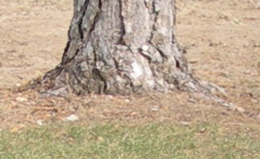 water. Only water when the air and soil temperatures are greater than 40 degrees Fahrenheit, with no snow cover. Plants that are on the south or west side of your house are more likely to dry out before those on the east or north. And plants that get reflected heat from buildings, walls and fences or that are in windy sites are more likely to dry out more quickly.
water. Only water when the air and soil temperatures are greater than 40 degrees Fahrenheit, with no snow cover. Plants that are on the south or west side of your house are more likely to dry out before those on the east or north. And plants that get reflected heat from buildings, walls and fences or that are in windy sites are more likely to dry out more quickly.
Recently planted deciduous trees are most in danger from winter dry spells. Established trees are somewhat immune from winter drought, unless the dry spell is extreme. If you are uncertain if your tree is established, observe this advice from Colorado State University Extension Service: “Trees generally take one year to establish for each inch of trunk diameter. For example, a two inch diameter (caliper) tree takes a minimum of two years to establish under normal conditions.“ Water the newer and younger trees once a month with 10 gallons of water per each trunk diameter, measured at 6 to 12” above the ground. Let the water soak in slowly to a depth of 12”.
Similarly, recently planted shrubs are more susceptible to dry winter conditions than more established shrubs. For new shrubs, water them with 5 gallons, two times per month. Small established shrubs need 5 gallons once per month. Large established shrubs need about 18 gallons per month.
Newly planted evergreen trees and shrubs are also very sensitive to winter drought, because they don’t drop their leaves or needles so they still are transpiring moisture through the needles all year long. Some arborists recommend misting the leaves/needles with water rather than focusing on the soil. Some of the water will trickle down and get into the soil. Consider doing this 3 times a month for those new evergreens. This should help your evergreens avoid the brown damaged needles that occur during drought stress. Evergreens that need special attention during winter drought are spruce, fir, arborvitae, yew, Oregon grape-holly, boxwood, and Manhattan euonymus.
Obviously, if we receive enough precipitation, no supplemental watering is needed. The rule of thumb here is if snow still covers the ground or if there was a significant snow fall (6” or more) at least once in the last month, you probably don’t need to water that month. But if we have a dry spell and you’ve not properly watered your landscape plants, they may become weakened, making them prone to insects and disease.
If you have a recently planted lawn, consider giving it ½” of water per month during winter dry spells. Established lawns shouldn’t need supplemental watering because bluegrass goes dormant in winter.
Do not neglect to properly mulch all your trees, shrubs and perennials. This will help to keep your plants from further drying out.
Once you have watered your landscape plants, don’t forget to unhook your hose from the hose bib so as to avoid frost damage to the pipes once temperatures drop back down below freezing.
This is the official blog of Outdoor Design Group, Colorado Landscape Architects. For more information about our business and our services, click here.
Related Posts:
by Todd Rutherford
When discussing Yucca plants with other people, I’m usually presented with two responses: the majority who detest them, and the few people who love them. If you are of the former, I hope I can convince you to move towards the latter group. Or at least I hope to persuade you to begin to reconsider the so-called “yucky Yuccas.”
There is one type of Yucca in particular that turned me into a Yucca fan. This would be Yucca filamentosa. This Yucca has all the things that make many Yuccas great for Colorado gardens: low water requirement, dramatic flowers that are pollinated at night by moths, and evergreen winter interest.
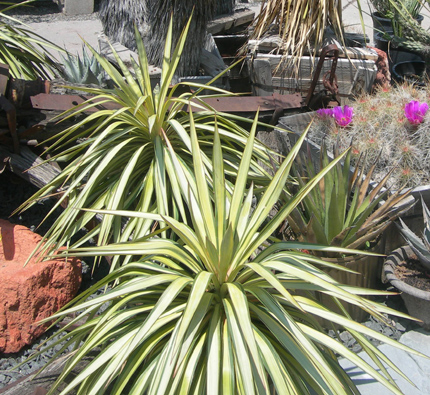
What Y. filamentosa has that other yuccas that can grow in our hardiness zone don’t have is softer leaves that can fold over towards the end, despite having sharp tips. This makes it a possibly better choice for gardeners who might be concerned about the stiff, sword like nature of some yuccas such as Y. glauca (which still make great landscape plants!). In addition these Yuccas can take some filtered shade, whereas most Yuccas prefer only full sun. Keep in mind that Yuccas, like many low-water garden plants prefer good drainage to avoid root rot. In addition to Adam’s Needle, there are a few other varieties of Y. filamentosa that offer variegated leaf color, such as Bright Edge Yucca and Color Guard Yucca.
Similar to Y. filamentosa is Y. flaccida. Y. flaccida hails from the Appalachian Mountains. Just like Y. filamentosa, Y. flaccida is more accustomed to your average garden soils and watering regimen. If you want to add a Yucca to an area that already contains other perennials that are not extremely xeric, you should consider Y. filamentosa and Y. flaccida. But while these two species can desire more water than the other yucca species, they are still low water plants that need well-drained soil to keep them happy.
If it is architectural drama you seek for your garden, consider planting Yucca thompsoniana. Thompson’s Yucca is native to New Mexico, Texas, and northern Mexico. Under the right conditions, it may reach up to 10 feet tall. Thompson’s Yucca stems can even sometimes branch off, giving a similar look to the famous Joshua Tree Yuccas (Yucca brevifolia). Flowers are borne on 3 to 5 foot spikes, further increasing the drama of these beauties. For inspiration I recommend you visit the Thompson Yuccas at the Denver Botanic Gardens.
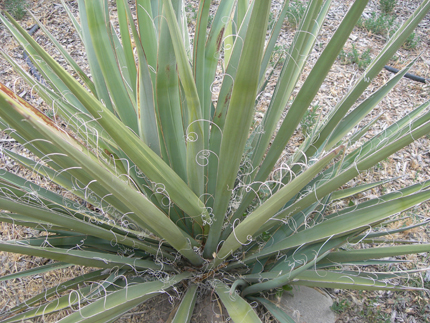
Another captivating form of Yucca is Y. baccata, commonly called Banana Yucca. It was a source of food for Native Americans of the Southwest. The long, stiff bluish-green leaves often curl back toward the base, and sport course curled fibers along the edges. Those curled fibers look striking in afternoon backlight. Banana Yucca can reach a height of 4 feet and width of 5 feet, so give it a good, dry space to thrive.
For native plant purists on Colorado’s Front Range, the Soapweed Yucca (Y. glauca) is a good choice. It is distributed widely across the high plains and foothills of Colorado, and is found from Canada to Texas. It is the most cold-hardy Yucca species available. As I mentioned previously, this Yucca has stiff leaves with sharp tips. Y. glauca grows 2-4’ tall and 2-4’ wide, and requires very little water.
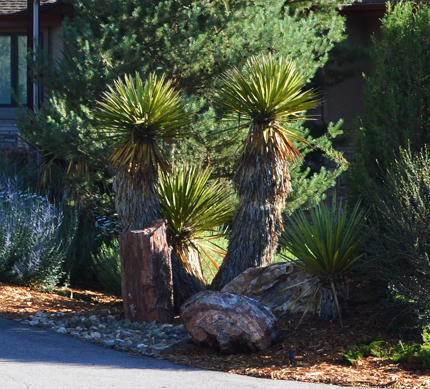
Yucca faxoniana
If you have been avoiding the so-called Yucky Yuccas, please reconsider your position and give one of these xeriscape essentials a spot in your low-water landscape.
This is the official blog of Outdoor Design Group, Colorado Landscape Architects. For more information about our business and our services, click here.
Related Posts:
by Todd Rutherford
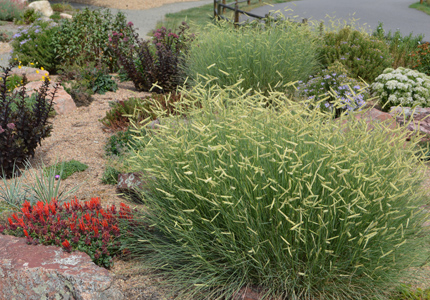
Teasing you with its profusion of blonde colored, eye-lash shaped seed heads, this ornamental selection of the western native Blue Grama grass will wow you. Introduced by David Salman of High Country Gardens, Bouteloua gracilis ‘Blonde Ambition’ was a 2011 Plant Select winner.
Resplendent on a sunny fall or winter day, the gold leaves and seed heads look great against small evergreens, a dark wall or landscape boulders. Even winter snows can’t stop this grass from providing captivating winter interest, as it seems to stand up through heavy snows better than other ornamental grasses. And in summer, the light blue-green foliage can’t be stopped by heat or drought. ‘BlondeAmbition’ mixes well with many xeriscape staples such as Autumn Joy Sedum or English Lavender, and also looks great in masses as well.
Would you like to attract some eyeballs to your landscape by reserving a spot in your garden for this blonde bombshell?
Scientific Name: Bouteloua gracilis ‘Blonde Ambition’
Plant Type: Perennial
Mature Height: 12”-36”
Mature Spread: 12”-24”
Cold Hardiness Zone: 4 – 9.
Water Requirement: Very low. Grows in a wide range of soil conditions.
Exposure: Full Sun.
Flower Color & Bloom Time: Chartreuse to Gold. Summer.
Winter Interest: Gold leaves and curly seed heads.
Best Features: Profusion of gold colored eye-lash shaped seed heads. Great color and shape throughout fall into winter.
Disadvantages: unknown
Availability and Sizes: This plant seems to be regularly available.
Maintenance Tip: Shear back in late winter / early spring to give room for new growth.
Wildlife Value: unknown
This is the official blog of Outdoor Design Group, Colorado Landscape Architects. For more information about our business and our services, click here.
Related Posts:




 water. Only water when the air and soil temperatures are greater than 40 degrees Fahrenheit, with no snow cover. Plants that are on the south or west side of your house are more likely to dry out before those on the east or north. And plants that get reflected heat from buildings, walls and fences or that are in windy sites are more likely to dry out more quickly.
water. Only water when the air and soil temperatures are greater than 40 degrees Fahrenheit, with no snow cover. Plants that are on the south or west side of your house are more likely to dry out before those on the east or north. And plants that get reflected heat from buildings, walls and fences or that are in windy sites are more likely to dry out more quickly.


